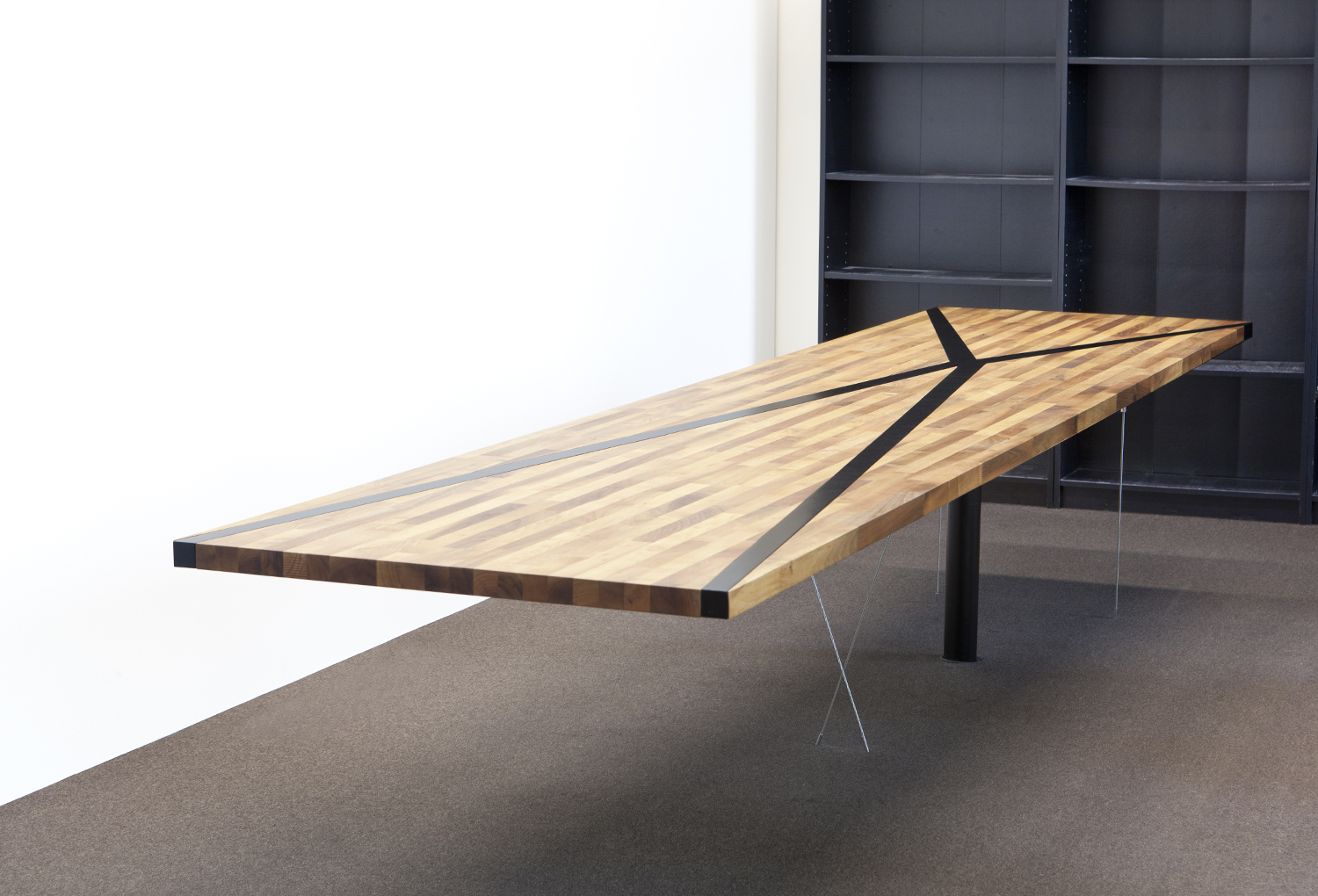
Counterpoise
2011
Design: Toni Kotni
Collaboration: Maximilian Schrems
Steelwork: Gebr. Gysi AG, Baar
Woodwork: Oliver Zgraggen, ETH Dienste
The dominant typology in table design is that of an object that occupies the room as a stable, self-contained element. The objecthood is
often reflected in the seclusion of a symmetrical disposition and the self-referentiality of the formal language. The unusual feature of the
project consists in breaking up this typology through inversion. The Counterpoise project is the expression of a dynamic balancing act; it
is a floating piece of furniture radiating into the surrounding space, with a reduced formal language in an unstable balance of forces.
Methodically, the project design is oriented towards principles of structural design in building construction. These principles are used to
find efficient solutions to the problem of large tabletop cantilevers. Aspects of material behaviour as well as methods for controlling the
flow of forces are adapted and applied to the scale and the requirements of furniture design. The project thus exemplifies the transfer of
knowledge from the large scale of architecture to the small scale of furniture design.
The adaptation of principles of structural design in building construction enables an expression of lightness and floating to be achieved,
which for physical reasons cannot be achieved with the usual constructive methods in furniture construction. By removing the direct
reference from the table top to the floor, a spatial effect can be generated that goes beyond the object and includes the surrounding space.
This effect on the outside is further enhanced by the shape of the supporting structure and the materialisation of the table top. However,
neither the form nor the material are staged by the design, but the supporting structure and its behaviour become the central means of
expression. By fusing the physically necessary with the creative will, a table has been created whose character is determined by the
expressive power of the supporting structure. This aspect of design has so far received little attention in furniture design due to the
dimensions and relatively low internal forces in the material. The project thus opens up the supporting structure as a further form of
expression for furniture design.
Project description: The term table goes back to the Greek dishos, the disc, and describes a piece of furniture which is characterized by
the horizontality of the table top. The project is an attempt to approach this original concept by interpreting the table as a dynamic
balancing act with the tabletop as a plane floating in space in a balance of forces. The substructure is therefore reduced to one support
and four cables through which the table top is balanced. This creates legroom and allows the table to be used to its full extent. Two
crossed and slightly elevated steel profiles are placed on the support. The profiles slender with increasing distance from the support and
are bent into the horizontal plane by two guy ropes, thereby pressing them onto the support and fixing them in position. The slendering,
superelevation and pretensioning of the profiles makes it possible to achieve large projections without visible bending of the table. In
addition to the pre-tensioning, the inclined position of two cables secures the profiles against horizontal displacement or rotation. The
table top is inserted into the spaces spanned by the crossed profiles. Because the supporting structure places high demands on the strength
and rigidity of the material, it was made of steel. Steel not only meets the mechanical requirements, but also has a low self-weight and is
cost-effective. In addition, it can be machined very well, which facilitates detailing and allows easy introduction of the cable forces into
the material. In contrast to this, the plate was made in finger-jointed lamellas of oiled walnut wood. This materialization differentiates
the different functions, through the visual and haptic differences as well as through the industrial and handicraft tradition that the
materials evoke. As the panel is inserted between the profiles, the supporting structure remains visible and becomes a central design
element. The cross-shaped position of the profiles not only creates space for the tabletop, but also defines a radial reference frame that
radiates beyond the edge of the table. This effect is enhanced by the asymmetrical position of the frame, the slendering of the steel
profiles starting from the centre and the direction of movement of the wooden lamellae. Due to the compression of the material around the
centre, the supporting structure is stiff and hardly bends at all, even under high vertical loads. If, on the other hand, the table is
loaded horizontally, the ropes elastically absorb the applied force, resulting in a gentle vibration of the table. The supporting structure
limits the table′s mobility to the horizontal plane and opens up an additional dimension in addition to visual perception, through which the
horizontal can be experienced.
last modified 4.2.2020